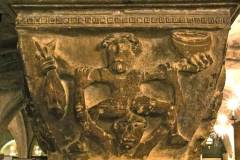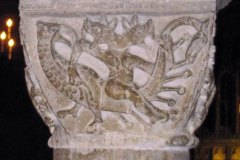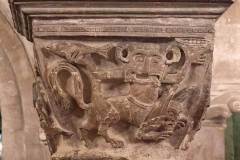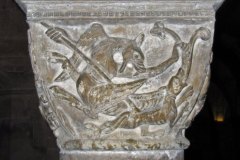The crypt at Canterbury is the largest and most striking in England. The western section (completed under Prior Ernulf around 1100) is built in the Norman (or Romanesque) style, and includes a large number of capitals (at the head of each pillar) decorated with strange Celtic pre-Christian images of animals, birds, griffins, dragons, monsters and men. It appears that these were cut, not by chisel, but with an axe, probably in a stone workshop and then hoisted in to place. Sixteen such carved columns stand in the western end of the crypt, approaching the Treasury. A further two stand in Gabriel’s chapel on the south side of the crypt, and two more in the chapel of the Holy Innocents on the north side. There are strong parallels between these images and those which appear in manuscripts of the period, in particular the so called ‘Bestiaries’ and images in ‘illuminated’ manuscripts.
The western crypt is the oldest visible part of the cathedral apart from fragments of Lanfranc’s building. It incorporates eight pairs of columns leading to the Treasury – there appears to have been an initial plan for alternate decorated and plain columns and capitals. The symmetry breaks down unfortunately for those beside the Treasury. Many of the symbols and compositions also appear in illuminated manuscripts of the same period. A few of the more striking examples are described in more detail below – the meaning of many of these was probably unclear even to those who carved them.
What to see:
- two tumbling acrobats with fish and bowl – there are several of the latter in the crypt and each time (as here) the fish is vertical, the bowl is empty and vice versa – but why?
- a wild two headed dog (wolf?) with fangs and female breasts possibly of Egyptian origin sits astride a dragon with heads at either end – known as an ‘amphisbaena’
- apart from the two headed monster (second head is lower right), this incorporates images of more fish (horizontal this time) and a bowl (full)
- winged monster spearing a dog
Source: see standard cathedral sources; also Kahn (1991); Vaux (1989)
For capitals in St Gabriel’s chapel click here.
DL




